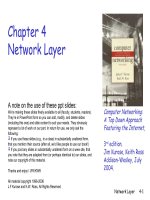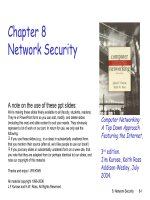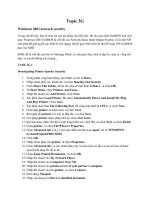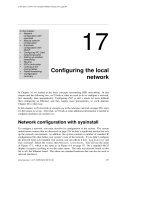17 network evolution
Bạn đang xem bản rút gọn của tài liệu. Xem và tải ngay bản đầy đủ của tài liệu tại đây (39.56 MB, 58 trang )
• No class on Thursday
• Exam Thursday 6PM in CEMEX
CS224W: Social and Information Network Analysis
Jure Leskovec and Baharan Mirzasoleiman, Stanford
¡
Evolving Networks are networks that change as a
function of time
¡
Almost all real world networks evolve over time either
by adding or removing nodes or links over time
¡
Examples:
§ Social networks: people make and lose friends and join or leave
the network
§ Internet, web graphs, E-mail, phone calls, P2P networks, etc.
Collaborations in the journal
Physical Review Letters (PRL)
[Perra et al. 2012]
11/27/18
Jure Leskovec, Stanford CS224W: Analysis of Network,
2
¡
Visualization of the student collaboration network
Nodes represent the students. An edge exists between two nodes if any of the two ever
reported collaboration with the other in any of the assignments used to construct the network
[Burstein et al. 2018]
11/27/18
Jure Leskovec, Stanford CS224W: Analysis of Network,
3
¡
Evolution of the pooled R&D network for the nodes belonging
to the ten largest sectors
[Tomasello et al. 2017]
11/27/18
Jure Leskovec, Stanford CS224W: Analysis of Network,
4
¡
Evolution of five selected sectoral R&D networks
Blue nodes represent the firms strictly belonging to the examined sector, while orange nodes
represent their alliance partners belonging to different sectors [Tomasello et al. 2017]
11/27/18
Jure Leskovec, Stanford CS224W: Analysis of Network,
5
¡
Evolving network structure of academic institutions
Community structure, indicated by color, for the networks from the three years 2011 to 2013.
Different communities are indicated by different colors.
[Wang et al. 2017]
11/27/18
Jure Leskovec, Stanford CS224W: Analysis of Network,
6
¡
The largest components in Apple’s inventor network over a 6year period
Each node reflects an inventor, each tie reflects a patent collaboration. Node colors reflect technology
classes, while node sizes show the overall connectedness of an inventor by measuring their total number of
ties/collaborations (the node’s so-called degree centrality).
[kenedict.com]
11/27/18
Jure Leskovec, Stanford CS224W: Analysis of Network,
7
¡
How do networks evolve?
§ How do networks evolve at the macro level?
§ Evolving network models, densification
§ How do networks evolve at the meso level?
§ Network motifs, communities
§ How do networks evolve at the micro level?
§ Node, link properties (degree, network centrality)
Microscopic:
Degree, centralities
11/27/18
Mesoscopic:
Motifs, communities
Jure Leskovec, Stanford CS224W: Analysis of Network,
Macroscopic:
statistics
8
¡
How do networks evolve at the macro level?
§ What are global phenomena of network growth?
¡
Questions:
§ What is the relation between the number of nodes
n(t) and number of edges e(t) over time t?
§ How does diameter change as the network grows?
§ How does degree distribution evolve as the
network grows?
11/27/18
Jure Leskovec, Stanford CS224W: Analysis of Network,
10
!(#) … nodes at time #
%(#) … edges at time #
¡ Suppose that
! # + ' = ) ⋅ !(#)
¡ Q: what is:
% # + ' = ? Is it ) ⋅ %(#)?
¡
¡
¡
A: More than doubled!
§ But obeying the Densification Power Law
11/27/18
Jure Leskovec, Stanford CS224W: Analysis of Network,
11
¡
¡
¡
Internet
E(t)
What is the relation between
the number of nodes and the
edges over time?
a=1.2
First guess: constant average
degree over time
Networks are denser over time
Densification Power Law:
N(t)
Citations
E(t)
¡
a … densification exponent (1 ≤ a ≤ 2)
11/27/18
Jure Leskovec, Stanford CS224W: Analysis of Network,
a=1.6
N(t)
12
¡
Densification Power Law
§ the number of edges grows faster than the
number of nodes – average degree is increasing
or
equivalently
a … densification exponent: 1 ≤ a ≤ 2:
§ a=1: linear growth – constant out-degree
(traditionally assumed)
§ a=2: quadratic growth – fully connected graph
11/27/18
Jure Leskovec, Stanford CS224W: Analysis of Network,
13
Prior models and intuition say
that the network diameter slowly
grows (like log N)
Internet
diameter
¡
size of the graph
Diameter shrinks over time
§ As the network grows the
distances between the nodes
slowly decrease
diameter
¡
Citations
How do we compute diameter in practice?
time
-- Long paths: Take 90th-percentile or average path length (not the maximum)
-- Disconnected components: Take only largest component or average only over connected pairs of nodes
11/27/18
Jure Leskovec, Stanford CS224W: Analysis of Network,
14
(answer by
simulation)
diameter
Is shrinking
diameter just a
consequence of
densification?
Erdos-Renyi
random graph
Densification
exponent a =1.3
size of the graph
Densifying random graph has increasing diameter
Þ There is more to shrinking diameter than
just densification!
11/27/18
Jure Leskovec, Stanford CS224W: Analysis of Network,
15
Is it the degree sequence?
Compare diameter of a:
diameter
§ Real network (red)
§ Random network with
the same degree
distribution (blue)
Citations
year
Densification + degree sequence
gives shrinking diameter
11/27/18
Jure Leskovec, Stanford CS224W: Analysis of Network,
16
How does degree distribution evolve to allow
for densification?
¡ Option 1) Degree exponent !" is constant:
¡
§ Fact 1: If !" = ! ∈ [&, (], then: * = (/!
Email network
11/27/18
A consequence of what
we learned in the Power
law lecture:
■ Power-laws with
exponents <2 have infinite
expectations.
■ So, by maintaining
constant degree exponent ,
the average degree grows.
Jure Leskovec, Stanford CS224W: Analysis of Network,
17
How does degree distribution evolve to allow
for densification?
¡ Option 2) !" evolves with graph size #:
¡
%#&'(
)(
"
§ Fact 2: If !" = *#&'()( , then: + = &
"
Citation network
11/27/18
Jure Leskovec, Stanford CS224W: Analysis of Network,
Notice: !0 → 2
as 30 → ∞
Remember, the
expected degree in a
power law is:
!" − (
,- =
&
!" − * /
So !" has to decay as
a function of graph size
#" for the avg. degree
to go up.
18
Want to model graphs that densify and have
shrinking diameters
¡ Intuition:
¡
§ How do we meet friends at a party?
§ How do we identify references when writing
papers?
w
11/27/18
v
Jure Leskovec, Stanford CS224W: Analysis of Network,
19
¡
The Forest Fire model has 2 parameters:
§ p … forward burning probability
§ r … backward burning probability
¡
The model: Directed Graph
§ Each turn a new node v arrives
§ Uniformly at random chooses an “ambassador” w
§ Flip 2 geometric coins (based on p and r) to
determine the number of in- and out-links of w to
follow
§ “Fire” spreads recursively until it dies
§ New node v links to all burned nodes Geometric distribution:
11/27/18
Jure Leskovec, Stanford CS224W: Analysis of Network,
20
¡
The Forest Fire model
§ (1) ! chooses an ambassador node " uniformly at random, and forms
a link to "
§ (2) generate two random numbers # and $ from geometric
distributions with means %/(1 − %) and +%/(1 − +%)
§ (3) ! selects # out-links and $ in-links of " incident to nodes that were
not yet visited and form out-links to them
§ (4) ! applies step (2) to the nodes found in step (3)
w
Example:
(1) Connect to a random node "
(2) Draw #=2, $=1
(3) Connect to 2 out- and 1 in-links
of ", namely a, b, c
(4) Repeat the process for a, b, c
11/27/18
v
a
c
b
Jure Leskovec, Stanford CS224W: Analysis of Network,
21
¡
Forest Fire generates graphs that densify
and have shrinking diameter
E(t)
densification
1.32
diameter
diameter
N(t)
11/27/18
Jure Leskovec, Stanford CS224W: Analysis of Network,
N(t)
22
¡
Forest Fire also generates graphs with
power-law degree distribution
in-degree
log count vs. log in-degree
11/27/18
out-degree
log count vs. log out-degree
Jure Leskovec, Stanford CS224W: Analysis of Network,
23
¡
¡
¡
Fix backward
probability r and
vary forward
burning prob. p
Notice a sharp
transition
between sparse
and clique-like
graphs
Increasing
diameter
Sparse
graph
Clique-like
graph
Constant
diameter
Decreasing
diameter
The “sweet spot”
is very narrow
11/27/18
Jure Leskovec, Stanford CS224W: Analysis of Network,
24









